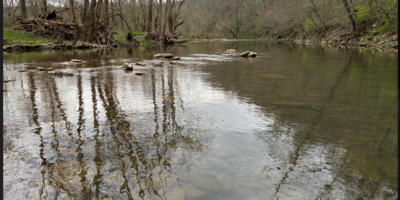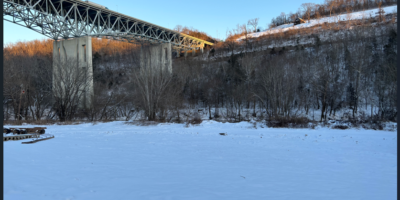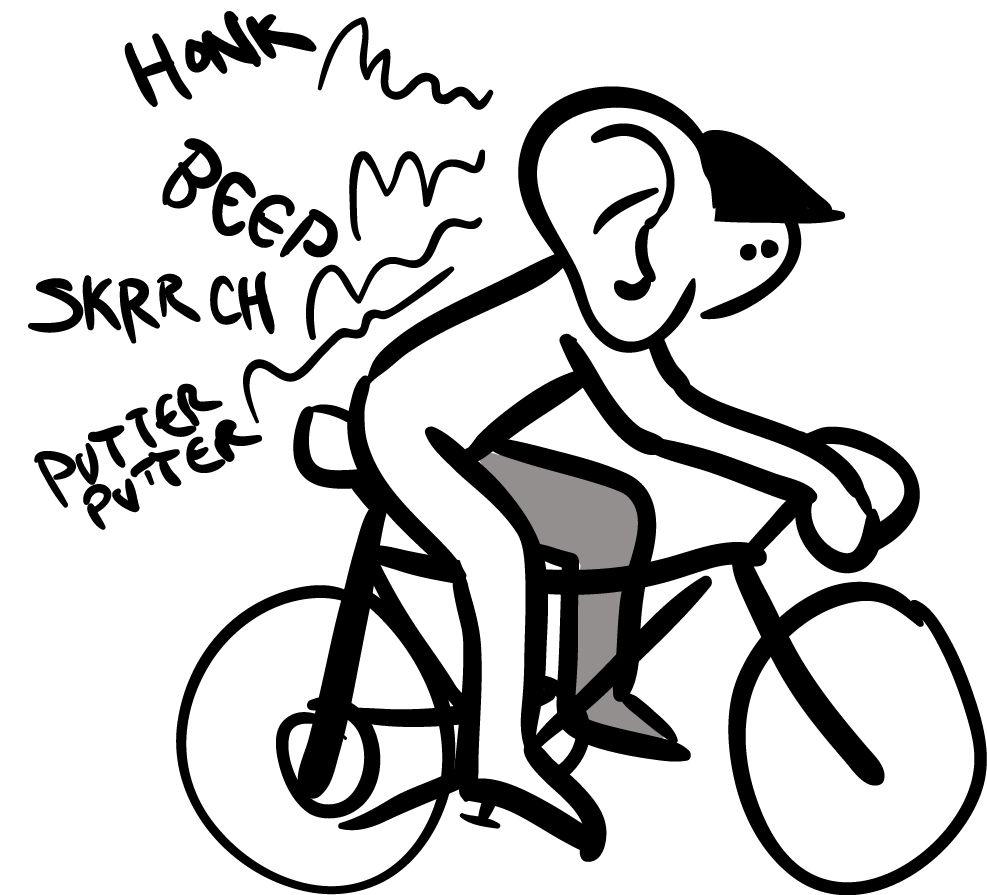Out on the streets, that’s where we’ll meet
By Captain Comannokers
NoC Transportation Czar
One reason I love riding a bike so much is that it is such a multi-sensory experience.
You can feel the wind on your face. (This time of year you can do so until you can no longer feel your face.) I’ve definitely tasted a few bugs – none of which I can recommend.
Without the enclosure most vehicles have, you can smell your surroundings pretty swiftly, too. Each neighborhood has its own distinct aroma depending on types of trees, nearby factories or other odorous factors.
Of course, your vision is constantly monitoring the road for dangers. Undoubtedly, it’s the sense we rely on the most to travel.
However, the under-utilized sense of sound can be one of the greatest assets a cyclist has – but you’ve got to put your ears to work for you.
It’s not always easy to peer over your shoulder. For instance, you may want to know if a vehicle is about to pass you, but you may also be riding on a rough patch of road that warrants keeping your eyes focused ahead.
In the winter, these situations can be compounded by wearing more gear on your head to keep yourself warm, which can limit your peripheral vision and muffle your hearing.
Of course, a mirror can go a long way in assisting a cyclist, but let’s work under the assumption that a good number of bikes don’t have them.
Your ears can be key in telling you what is happening out on the road. The majority of the time, you should be able to hear any vehicle approaching you simply by the sound of it, and you can usually tell when they are at least 100 feet behind you (probably more, but I haven’t been able to get off my bike to measure this). This can help you determine what actions to take – do you need to slide a bit to the right because of the size of the road, and can you? Are you trying to get left to position yourself for an upcoming turn at a light? Carefully listening can help you make the best decisions.
Also, your ears can tell you the difference between a MINI Cooper and a UPS truck, which can often alter your steering or position. Using your ears to differentiate sounds while riding is a skill that can be fine-tuned and is extremely beneficial.
Some folks like to honk their horns at cyclists when they feel the cyclist is in the wrong. First, you need to determine what the honk is for – is it directed at you? Or is it meant for some other vehicle or pedestrian? Be alert to the situation.
Also, a general note to drivers out there – if you see someone you know on a bike and there is any amount of traffic, don’t honk. Tell them later that you saw them on Tates Creek around 4:30. You can have a great chuckle about it then, but honking your horn is probably not the best option to say “hello.” If you see them in your neighborhood, and there is not a soul around – well then hell, honk at ‘em like you mean it, I guess, if that’s your thing.
Another important way to use your ears : listen to what your bike is trying to tell you. Bikes can make all kinds of peculiar noises when something is not right. Is something rubbing or grinding against something else? Is something clacking when it should be clicking? Listening for problems is important – occasionally it may be something you can adjust on the fly and safely be on your way. Other times, your bike may be telling you it needs serious repair. Don’t ignore these sounds – doing so could put you in real danger.
Do I even have to mention? Yes, I probably do: don’t talk on your cell phone while riding. If you get an urgent call, just pull over for a damn minute. Furthermore, having earbuds or headphones on while riding is about as wise as purchasing a snowmobile in Mobile, Alabama. I love music and I love riding my bike, but I also like to be alive. To appease both of my loves, I am planning to attach a harmonica rack to the handlebars of my bike in spring. It could replace the need for a bell, and I promise I won’t play it in traffic. I also won’t play the solo from “I Guess That’s Why They Call It The Blues” by Elton John – I’ve always hated that harmonica part.
Now on to the Mailbag…
Hit and run at Ashland
A few weeks back, I asked for particular intersections readers deemed difficult or dangerous. I wish this report filed by Christina Buckner could have simply been a precautionary tale about travelling at the intersection at High and Ashland. Instead, it is the story of a hit and run. Christina was heading north on Ashland and was proceeding through a green light.
I started commuting by bike every day about two years ago. Since then, I have been yelled at on numerous occasions to “Get off the road!” (despite the fact that cyclists are legally allowed to share the road), car-doored once by a driver exiting a parked car, and hit twice. The first time was a hit and run by a drunk driver; the second instance occurred this past week as I was taking my usual route home from work.
I was attempting to cross an intersection where I had the right of way but was cut off by a line of cars in the oncoming traffic that were turning left (they had a green light but not a turn signal). I entered the intersection with caution, as I never assume drivers have seen me. As the first driver sped by, almost clipping my front wheel, I gave them the benefit of the doubt that, despite the brightness of my LED front light, perhaps the darkness and snow had obscured me from their vision. The second and third drivers, however, could not have avoided noticing me, as I was blocking the intersection prominently enough to cause them to greatly narrow their turn.
I was forced to linger in the frigid weather as the drivers, cloistered from the elements in their toasty climate controlled vehicles, whizzed on. As the third driver passed, the light turned red. Not wanting to obstruct the intersection, I started to quickly cross, but before I could extricate myself from my predicament, a fourth car turning left floored their gas to run the red light.
As I made eye contact with the driver, his eyes simply looked bemused, and he shook his head and chuckled as his foot slammed on the break and the left side of his bumper collided into my left hip and back wheel. My bike skidded forward as I flew over my frame and landed on my side a couple of feet from my bike. The driver sped on. The traffic to my left, which now had a green light, noticed my prostrate figure writhing on the frozen pavement only after a few seconds, coming to halt a few feet from running me over. Only one person left their vehicle to check on my condition and help me out of the intersection.
When I finally was safe and dry in my house, I reflected on the situation over and over—could I have done anything differently to avoid what could have been, but what thankfully wasn’t, a devastating wreck? I wonder if the driver who hit me did the same, and I wonder if any driver who has hit or cut off a cyclist (whether by accident or not), has stopped to reflect how close they came to killing or seriously injuring another human being. Considering how carelessly many drivers act toward my presence next to them, I’ve come to really doubt whether or not they do actually recognize me as a person, or whether I become simply an obstacle preventing them from speeding to their destination.
But I am a person, and such inattention or aggression towards cyclists endangers our lives. I wanted to catch the person who hit me and ask him, “Would you wave a loaded gun haphazardly around in front of a stranger’s face?” Because driving recklessly next to cyclists and pedestrians is just as deadly of an act. A car is a weapon and drivers need to remember that responsibility. – Christina Buckner
Let’s hear more about the problematic intersections in town, so we can have discussions about ways to make them safer for everyone. I’d especially like to hear from some drivers. Get on to noclexington.com, find this story and comment away, or email me at ShareTheRoadLex@gmail.com. This is your Captain – over and out.





Leave a Reply